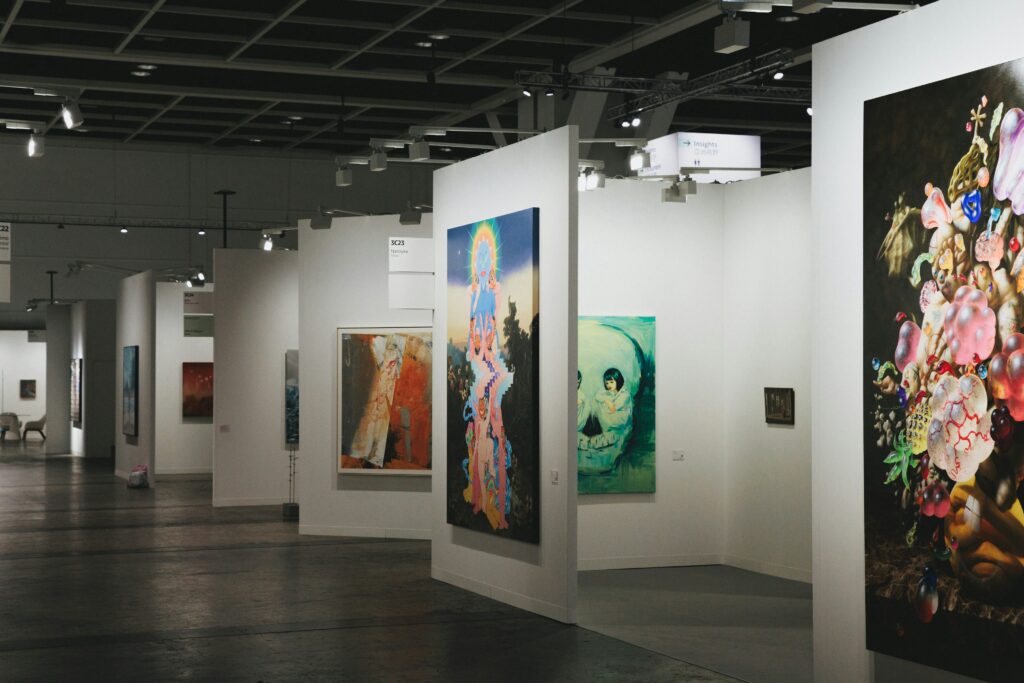Know Before You Go: Researching the Exhibition
Walking into an exhibition without context can leave you missing key layers of meaning. A few minutes of thoughtful preparation can turn a casual visit into a deeper, more engaging experience. Here’s how to do that effectively:
Start with Basic Research
Before you step into the gallery or museum, take time to learn about the artist, curator, or central theme.
- Who is the artist? What drives their work?
- Has the curator presented any previous notable exhibitions?
- What is the main message or focus of the exhibit?
A quick search online or a look through recent reviews can offer valuable insights and help you connect with the works on a more personal level.
Understand the Cultural and Historical Context
Art does not exist in a vacuum. Consider the broader contexts that shape the exhibition.
- Are there political or social issues tied to the work?
- Is the artist commenting on a specific historical event or movement?
- What cultural references might be informing the pieces on display?
Digging into these layers can enrich your perspective and uncover hidden meanings.
Preview the Layout When Possible
Many galleries and museums publish floor plans or walkthroughs of their exhibitions. Use these to get a sense of how the exhibit flows.
- Does the layout follow a timeline or thematic structure?
- Are there distinct sections that guide the viewer step-by-step?
- Where do you want to spend the most time?
Knowing what to expect can help you pace your visit and ensure you don’t miss key highlights or thematic transitions.
A Closer Look: Breaking Down a Single Work
When analyzing a single piece of art deeply, it’s not just about what you see—it’s about unpacking how and why each element contributes to the overall impact. Every material, line, and absence of space can carry meaning. Here’s how to approach it.
Materials and Techniques
Start by observing what the piece is made of. The medium often tells a story of its own.
- Is it traditional—oil on canvas, charcoal, clay?
- Or does it use unconventional materials like found objects, fabric, or digital tools?
- What techniques are noticeable—layering, carving, collage, mixed media?
The artist’s choices in materials and methods can reflect cultural background, artistic influences, or the emotional tone they wanted to convey.
Scale and Presentation
Scale impacts how we engage with a piece.
- Is it monumental, drawing you in with its physicality?
- Or is it intimate, requiring close inspection?
- Is it installed on a wall, placed on the floor, suspended, or interactive in nature?
The way a piece is presented shapes how viewers relate to it physically and emotionally.
Visual Elements: Color, Form, and Texture
Dig into the visual components.
- Color: Is the palette bold, muted, harmonious, or jarring? What feelings does it evoke?
- Form: Are the shapes geometric or organic? Is there repetition, symmetry, or imbalance?
- Texture: Is the surface smooth, rough, layered, or tactile from a distance?
- Negative Space: How does empty space interact with the form? Is absence used intentionally?
These elements work together to guide the viewer’s eye and build meaning.
Interpreting Meaning and Motifs
Go beyond the visuals.
- What’s being shown? Is it figurative, abstract, symbolic?
- How is it being shown? Is the viewpoint skewed or straightforward? Are certain elements emphasized or obscured?
- Why this way? What could the artist be exploring—identity, memory, conflict, transformation?
Look for recurring symbols or patterns. They might point to broader themes like fragility, resistance, hope, or disconnection.
Putting It All Together
When you connect how the elements function with what they’re presenting, analysis becomes interpretation. A successful breakdown reflects how each detail—however small—contributes to an idea, emotion, or message greater than the sum of its parts.
Introduction
Vlogging isn’t new, but it’s proven tougher than most expected. Even as attention spans shrank and platforms multiplied, creators kept the format alive by adapting hard and fast. From longform day-in-the-life edits to two-minute storytelling bursts, vloggers figured out how to stay relevant in a world that prefers fast, loud, and constantly moving.
Now, 2024 is pushing a major shift. What worked two years ago might not fly today. Algorithms are getting smarter and stingier. Audiences want more than just entertainment — they want connection, insight, and value. That means creators can’t bank on hacks or viral luck anymore. To grow, they need to understand what their audience wants in real time and deliver it with clarity and consistency. It’s less about chasing trends and more about owning your lane. If you’re creating on autopilot, good luck. But if you’re willing to pivot with purpose, there’s still room to win.
Lighting hits first. Is it warm and inviting or clinical and sharp? Natural light can soften the mood, give the sense that what you’re about to witness is grounded and honest. Harsh LEDs might say the opposite: this is high-production, no-nonsense. Spacing follows close behind. Cramped visuals make things feel chaotic unless used intentionally. Open layouts—foreground to background—let your eyes breathe and set a rhythm.
Then sound. Silence that draws you in or background noise that distracts? Good vloggers know their sonic environment is just as emotional as images. Clear audio, ambient music, or even quiet background buzz all help plant the viewer in the right headspace.
Now signage and text. Is information dropped on you like roadside debris, or is it deliberately placed to clue you in without yelling? Strong visual guides—font choice, subtitle timing, callouts—don’t just inform. They steer you.
First impressions are split-second judgments. Some creators go all in on polished branding. Others aim to feel raw and real. Either way, the successful ones make that choice on purpose. Nothing is random. Every design decision guides us—whether through a story arc, emotion shift, or a literal transition. Done well, you don’t even notice. You just follow.
Make the Most of a Museum Visit as a Creator
Museums can be surprisingly rich sources of creative inspiration. But to truly benefit from a visit, it helps to approach it with a bit of strategy. Here’s how creators can use museums not just as a casual outing, but as a creative reset space.
Choose Your Timing Wisely
Large crowds can be overwhelming—and distracting. To get the most from the visuals and atmosphere:
- Visit during off-peak hours, such as weekday mornings or late afternoons
- Avoid weekends or holidays when museum foot traffic is at its highest
- Use the quiet to fully immerse in the art or exhibits without external noise
Capture Your Thoughts on the Spot
Don’t rely on memory alone. Creative sparks tend to fade quickly once you leave an exhibit:
- Bring a small notebook to jot down ideas
- Use your phone notes app to write reflections or sketch shapes and compositions that catch your eye
- Write down the emotions certain artworks evoke—you can revisit these for future projects
Revisit for Deeper Insight
The first visit may give you surface-level impressions. But returning to the same exhibit can offer new creative angles:
- Go back with a specific focus, like color, texture, or storytelling
- Notice how different times of day or changing moods affect what stands out to you
- Build layered interpretations over time—each visit uncovers something new
By turning your museum time into a creative habit, you can build a steady flow of inspiration for your work that lasts far beyond the initial visit.
When watching a vlog or exploring any creative work, it’s worth glancing at the context—the titles, descriptions, artist statements—but don’t let those become gospel. Let the content hit you on its own terms first. Trust your gut response before reaching for the intended meaning.
Ask yourself: what story is being told here? Is it something almost anyone could connect with, or does it speak a specific language that needs decoding? Creators today often play the line between clarity and ambiguity. Both approaches can work, but knowing which one you’re experiencing gives you more footing as a viewer.
Finally, think about impact. Does the work provoke? Does it stir up something from your past or challenge something you’ve assumed? Great content tends to start conversations, not just complete a sentence.
Before you scroll to the next trend, pause. Let it sit for a second. What part hit you? What line replayed in your head? This isn’t just about tips and tactics — it’s about what shifts your perspective.
Maybe something challenged how you’ve been working. Maybe it gave language to an instinct you’ve ignored. Reflect on what stuck. Note it. Say it loud. Let that spark shape your view moving forward.
Every section in this article is a snapshot of where digital storytelling is going. Your job isn’t just to take it in. It’s to respond. Think about how you fit in — and where you want your voice to land.
You Don’t Need an Art Degree to Engage with Art
Art is for everyone. You don’t need formal education or training to appreciate it, question it, or participate in the conversation around it. Some of the most valuable insights come from simply being present and reacting honestly.
Start with Your Own Response
It’s okay if your first reaction is confusion, curiosity, or even dislike. That reaction is the beginning of the dialogue between you and the artwork.
- What do you notice first?
- How does it make you feel?
- Does it remind you of something personal or cultural?
Your instincts are valid. At the same time, they’re just a starting point.
Trust Yourself but Stay Curious
You are allowed to like what you like. But be open to asking why you respond a certain way. Art often invites you to reflect on your perspective and assumptions.
- Challenge surface-level reactions by asking deeper questions
- Look up the artist’s background or inspiration for added context
- Consider how your own experiences shape the way you see the piece
Art Is a Conversation
Art sparks dialogue, not just admiration. It’s designed to make you feel, ask questions, and share perspectives. Don’t hold back your thoughts—your voice is part of what brings the work to life.
- Discuss with friends, in person or online
- Ask questions instead of searching for “right” answers
- Let your interpretation evolve over time
Engaging with art doesn’t require expertise, just openness. Start the conversation, and bring your own perspective to the table.
If your brain needs a break from analytics and editing timelines, art might be the reset button you’re looking for. Contemporary exhibits are stepping it up this year, blending tech, social commentary, and wild creativity that hits different when you’re used to life behind a lens. Whether you’re vlogging your way through cultural commentary or just need some visual fuel, a solid art experience can refresh your direction.
If you’re mapping out exhibits to explore, check out this round-up: Top Contemporary Art Exhibitions to Visit This Year




